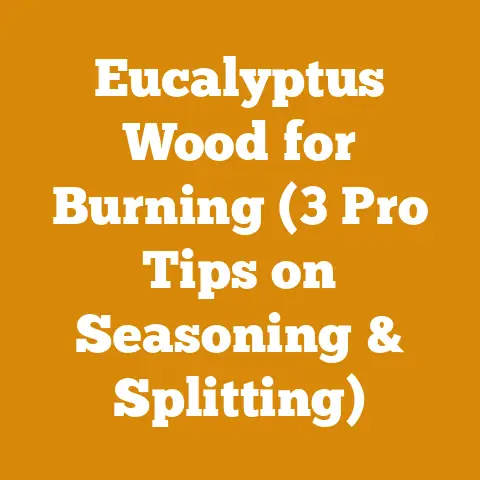Pink Fungus on Wood (5 Proven Wood Treatment Tips)
Alright, let’s tackle this pink fungus problem head-on.
I’ve seen my fair share of funky growths on wood over the years, and while pink fungus might look alarming, it’s often manageable.
I’m going to share my proven wood treatment tips to help you identify, deal with, and prevent pink fungus from ruining your lumber or firewood.
Let’s get started!
Pink Fungus on Wood: (5 Proven Wood Treatment Tips)
Pink fungus on wood can be a real headache, but don’t panic!
It’s often more of an aesthetic issue than a structural one, especially in its early stages.
Through my years of experience dealing with wood, I’ve learned that early detection and proper treatment are key.
This guide will walk you through identifying pink fungus, understanding its causes, and applying effective treatment methods to protect your wood.
Identifying Pink Fungus: What Am I Looking At?
The first step is to accurately identify what you’re dealing with.
Pink fungus on wood isn’t always a single type of organism.
It can refer to several different species, often grouped together due to their similar appearance.
- Color: The most obvious sign is, of course, the pink color.
This can range from a pale, almost white-pink to a vibrant, bubblegum hue.
The color might be more intense when the fungus is actively growing and fade as it dries out. - Texture: The texture can vary.
Some pink fungi appear as a slimy or cottony growth on the surface of the wood.
Others might be more crust-like or powdery. - Location: Where you find the fungus can offer clues.
Is it on freshly cut lumber, seasoned firewood, or structural timber?
Different environments favor different types of fungi. - Wood Type: Certain wood species are more susceptible to fungal growth than others.
Softwoods like pine are generally more vulnerable than hardwoods like oak.
Common Types of Pink Fungus:
- Aureobasidium pullulans: This is a common saprophytic fungus (meaning it feeds on dead organic matter) that can appear pinkish, especially in its early stages.
It’s often found on painted surfaces and can also colonize wood. - Fusarium species: Many Fusarium species can produce pink or reddish pigments.
These fungi are often associated with plant diseases and can also colonize wood, especially if it’s already damaged or stressed. - Pink Rot Fungi: This is a broad term for fungi that cause a pinkish discoloration in wood as part of the decay process.
These are often more serious as they can weaken the wood’s structure.
My Personal Experience:
I remember once I was helping a friend mill some pine logs he’d harvested from his property.
A few weeks later, he called me, worried about a pinkish slime growing on the lumber.
After taking a closer look, it turned out to be Aureobasidium pullulans.
We were able to treat it effectively with a borate solution and improved airflow.
Takeaway:
Accurate identification is crucial.
Take clear photos and compare them with images online.
If you’re unsure, consider consulting a local arborist or mycologist (fungus expert).
Why Is This Happening? The Root Causes of Pink Fungus
Understanding the conditions that promote pink fungus growth is essential for prevention and effective treatment.
Fungi thrive in specific environments, and by controlling these factors, you can significantly reduce the risk of infestation.
- Moisture: This is the number one culprit.
Fungi need moisture to grow and reproduce.
Wood with a high moisture content (above 20%) is particularly vulnerable.
Poorly ventilated areas, damp basements, and wood exposed to rain or snow are prime breeding grounds. - Warmth: While some fungi can tolerate cold temperatures, most prefer warmer conditions.
Temperatures between 60°F and 90°F (15°C and 32°C) are ideal for many fungal species. - Nutrients: Fungi feed on organic matter, and wood provides a readily available food source.
Decaying wood, in particular, is rich in nutrients that fungi can easily access. - Poor Air Circulation: Stagnant air traps moisture and creates a humid environment that favors fungal growth.
Proper ventilation is crucial for drying out wood and preventing infestations. - Untreated Wood: Wood that hasn’t been treated with preservatives is more susceptible to fungal attack.
Preservatives create a barrier that prevents fungi from penetrating the wood and accessing nutrients.
Data and Insights:
According to the USDA Forest Service, wood decay fungi require a moisture content of at least 20% to thrive.
Reducing the moisture content below this level is a primary strategy for preventing fungal growth.
Studies have also shown that proper ventilation can reduce the risk of fungal infestations by up to 50%.
My Personal Experience:
I once stored a stack of oak firewood in a poorly ventilated shed.
Despite being a relatively durable wood, it developed a significant mold problem, including patches of pink fungus.
I learned my lesson – even hardwoods need proper airflow to prevent fungal growth.
Takeaway:
Control moisture, ensure good ventilation, and consider treating wood with preservatives to prevent fungal growth.
Treatment Tip 1: Drying Out the Wood: The Foundation of Fungus Control
The most crucial step in treating pink fungus is to reduce the moisture content of the wood.
Without moisture, the fungus cannot survive.
- Increase Ventilation: This is often the simplest and most effective method.
Open windows and doors to allow air to circulate freely around the wood.
Use fans to improve airflow in enclosed spaces. - Sunlight Exposure: Sunlight is a natural disinfectant and can help to dry out wood.
Expose the affected wood to direct sunlight for several hours each day.
Be careful not to overexpose it, as excessive sunlight can cause cracking and warping. - Dehumidifiers: In damp environments, dehumidifiers can be used to lower the humidity level and dry out the wood.
Aim for a relative humidity of below 50%. - Kiln Drying: For lumber, kiln drying is the most effective way to reduce moisture content to a safe level (typically below 19%).
This is a controlled process that uses heat and airflow to remove moisture from the wood.
Practical Tips:
- When stacking firewood, leave gaps between the logs to allow for air circulation.
- Store firewood off the ground to prevent moisture from wicking up from the soil.
- Cover firewood during rainy or snowy weather, but ensure adequate ventilation to prevent moisture buildup.
- Use a moisture meter to monitor the moisture content of the wood.
Measurements and Specifications:
- Target moisture content for firewood: 15-20%
- Target moisture content for lumber: 6-12% (depending on the application)
- Ideal relative humidity for wood storage: below 50%
My Personal Experience:
I once salvaged a load of walnut lumber that had been improperly stored and had developed a significant mold problem.
I spent weeks meticulously stacking the lumber with spacers to maximize airflow and using fans to circulate the air.
It took time, but I was able to dry the wood out and save it from further damage.
Takeaway:
Drying out the wood is the cornerstone of any pink fungus treatment strategy.
Focus on increasing ventilation, exposing the wood to sunlight, and using dehumidifiers or kiln drying to reduce moisture content.
Treatment Tip 2: Surface Cleaning: Removing the Visible Fungus
Once you’ve addressed the moisture issue, the next step is to remove the visible fungus from the surface of the wood.
This can be done using a variety of methods, depending on the severity of the infestation and the type of wood.
- Scrubbing with Soap and Water: For mild cases, scrubbing the affected area with a stiff brush and a solution of soap and water may be sufficient.
Use a mild detergent and avoid harsh chemicals that could damage the wood. - Bleach Solution: A diluted bleach solution (1 part bleach to 10 parts water) can be effective for killing surface mold and fungus.
However, bleach can also discolor wood, so test it on an inconspicuous area first.
Always wear gloves and eye protection when working with bleach. - Vinegar: White vinegar is a natural disinfectant that can be used to kill mold and fungus.
Apply it to the affected area and let it sit for several minutes before scrubbing it off.
Vinegar is less likely to discolor wood than bleach. - Sanding: For more stubborn cases, sanding the affected area may be necessary.
Use a coarse-grit sandpaper to remove the surface layer of wood, including the fungus.
Be sure to wear a dust mask to protect yourself from inhaling wood dust and fungal spores.
Tool List:
- Stiff brush
- Bucket
- Mild detergent
- Bleach (optional)
- White vinegar
- Spray bottle
- Sandpaper (various grits)
- Dust mask
- Gloves
- Eye protection
My Personal Experience:
I once had a small patch of pink fungus growing on a cedar fence post.
I tried scrubbing it with soap and water, but it didn’t completely remove the stain.
I then used a diluted bleach solution, which effectively killed the fungus and removed the discoloration.
However, I had to be careful to rinse the area thoroughly to prevent the bleach from damaging the wood.
Takeaway:
Surface cleaning removes the visible fungus and helps to prevent it from spreading.
Choose the appropriate cleaning method based on the severity of the infestation and the type of wood.
Treatment Tip 3: Borate Treatment: A Powerful Fungicide
Borate treatments are highly effective for preventing and controlling fungal growth in wood.
Borates are naturally occurring minerals that are toxic to fungi but relatively safe for humans and animals when used properly.
- How Borates Work: Borates penetrate the wood and create a protective barrier that inhibits fungal growth.
They are particularly effective against wood-decaying fungi and insects. - Types of Borate Treatments: Several borate-based products are available for treating wood, including:
- Disodium Octaborate Tetrahydrate (DOT): This is a common borate compound used for wood preservation.
It’s typically applied as a solution in water. - Borax: Borax is another borate compound that can be used to treat wood.
It’s less effective than DOT but is more readily available. - Proprietary Borate Products: Several commercial wood preservatives contain borates as their active ingredient.
These products often include other additives to enhance their effectiveness and penetration.
- Disodium Octaborate Tetrahydrate (DOT): This is a common borate compound used for wood preservation.
- Application Methods: Borate treatments can be applied in several ways:
- Spraying: This is a common method for treating large surfaces, such as lumber or siding.
- Brushing: Brushing is suitable for smaller areas or for applying a more concentrated treatment.
- Soaking: Soaking wood in a borate solution is the most effective method for deep penetration.
This is often used for treating posts or timbers that will be in contact with the ground. - Pressure Treatment: This is an industrial process that forces borate solution deep into the wood under high pressure.
Pressure-treated wood is highly resistant to fungal decay and insect attack.
Measurements and Specifications:
- Typical concentration of DOT solution: 1.5-2% by weight
- Application rate: Apply until the wood is saturated
- Drying time: Allow the wood to dry completely before applying any finishes
My Personal Experience:
I once used a borate solution to treat a stack of ash lumber that I was using to build a workbench.
I sprayed the lumber thoroughly with the solution and allowed it to dry for several days.
The borate treatment not only prevented fungal growth but also protected the wood from insect attack.
Takeaway:
Borate treatments are a powerful tool for preventing and controlling fungal growth in wood.
Choose the appropriate borate product and application method based on the type of wood and the intended use.
Treatment Tip 4: Applying Wood Preservatives: Long-Term Protection
Wood preservatives are designed to protect wood from fungal decay, insect attack, and weathering.
They create a barrier that prevents fungi and insects from penetrating the wood and accessing nutrients.
- Types of Wood Preservatives:
- Oil-Based Preservatives: These preservatives contain oil-soluble fungicides and insecticides.
They are highly effective but can be messy to apply and may not be suitable for all applications.
Examples include creosote and pentachlorophenol.
(Note: Pentachlorophenol is restricted or banned in many countries due to its toxicity.) - Water-Based Preservatives: These preservatives contain water-soluble fungicides and insecticides.
They are easier to apply than oil-based preservatives and are less likely to discolor wood.
Examples include copper azole and alkaline copper quaternary (ACQ). - Clear Wood Preservatives: These preservatives are designed to protect wood without altering its appearance.
They typically contain fungicides and insecticides in a clear solvent.
- Oil-Based Preservatives: These preservatives contain oil-soluble fungicides and insecticides.
- Application Methods:
- Brushing: This is the most common method for applying wood preservatives.
Use a high-quality brush and apply the preservative evenly to all surfaces of the wood. - Spraying: Spraying can be used to apply preservatives to large surfaces quickly.
However, it’s important to ensure that the preservative is applied evenly and that all surfaces are adequately covered. - Dipping: Dipping wood in a preservative solution is an effective way to ensure that all surfaces are treated.
This is often used for treating fence posts or other timbers that will be in contact with the ground. - Pressure Treatment: As mentioned earlier, pressure treatment is an industrial process that forces preservatives deep into the wood under high pressure.
- Brushing: This is the most common method for applying wood preservatives.
Practical Tips:
- Always follow the manufacturer’s instructions when applying wood preservatives.
- Wear gloves, eye protection, and a respirator when working with wood preservatives.
- Apply preservatives in a well-ventilated area.
- Dispose of used preservatives and containers properly.
My Personal Experience:
I once built a deck using pressure-treated lumber.
I also applied a clear wood preservative to the deck boards to provide additional protection against weathering and fungal decay.
The deck has held up beautifully for many years, thanks to the combination of pressure treatment and preservative application.
Takeaway:
Wood preservatives provide long-term protection against fungal decay, insect attack, and weathering.
Choose the appropriate preservative based on the type of wood, the intended use, and the environmental conditions.
Treatment Tip 5: Prevention is Key: Long-Term Strategies
The best way to deal with pink fungus is to prevent it from growing in the first place.
Implementing long-term strategies to control moisture, ensure good ventilation, and protect wood from the elements is crucial for maintaining its health and longevity.
- Proper Wood Storage:
- Store lumber and firewood in a dry, well-ventilated area.
- Stack wood off the ground to prevent moisture from wicking up from the soil.
- Cover wood during rainy or snowy weather, but ensure adequate ventilation to prevent moisture buildup.
- Regular Inspections:
- Inspect wood regularly for signs of fungal growth, insect attack, or decay.
- Address any problems promptly to prevent them from spreading.
- Good Ventilation:
- Ensure that buildings and structures are properly ventilated to prevent moisture buildup.
- Install vents in crawl spaces and attics to promote airflow.
- Water Management:
- Ensure that rainwater is directed away from buildings and structures.
- Repair any leaks promptly to prevent water damage.
- Use of Durable Wood Species:
- When building structures or furniture, choose durable wood species that are naturally resistant to fungal decay and insect attack.
Examples include cedar, redwood, and cypress.
- When building structures or furniture, choose durable wood species that are naturally resistant to fungal decay and insect attack.
- Proper Construction Practices:
- Use proper construction techniques to prevent moisture from entering buildings and structures.
- Install flashing around windows and doors to prevent water intrusion.
- Use pressure-treated lumber for any wood that will be in contact with the ground.
My Personal Experience:
I learned the importance of prevention the hard way.
After neglecting to properly store some valuable cherry lumber, I discovered a significant mold problem.
I had to spend a considerable amount of time and effort cleaning and treating the wood.
Now, I’m meticulous about wood storage and regularly inspect my lumber for any signs of trouble.
Actionable Metrics:
- Monitor moisture content of wood regularly.
- Inspect wood structures at least twice a year.
- Maintain proper ventilation in buildings and structures.
- Address any water leaks promptly.
Takeaway:
Prevention is the most effective way to protect wood from pink fungus and other forms of decay.
Implement long-term strategies to control moisture, ensure good ventilation, and protect wood from the elements.
Additional Considerations: Safety and Environmental Concerns
When dealing with pink fungus and applying wood treatments, it’s important to consider safety and environmental concerns.
- Personal Protective Equipment (PPE): Always wear appropriate PPE when working with wood treatments, including gloves, eye protection, and a respirator.
- Ventilation: Apply wood treatments in a well-ventilated area to avoid inhaling harmful fumes.
- Disposal: Dispose of used wood treatments and containers properly according to local regulations.
- Environmental Impact: Choose wood treatments that are environmentally friendly and have minimal impact on the environment.
- Children and Pets: Keep children and pets away from treated wood until it is completely dry.
Expert Advice:
Consult with a qualified professional before applying any wood treatments, especially if you have concerns about safety or environmental impact.
Takeaway:
Prioritize safety and environmental responsibility when dealing with pink fungus and applying wood treatments.
Conclusion: Winning the Battle Against Pink Fungus
Dealing with pink fungus on wood can be frustrating, but with the right knowledge and techniques, it’s definitely manageable.
Remember, early detection, proper treatment, and long-term prevention are key to protecting your wood and maintaining its beauty and integrity.
By following the proven tips I’ve shared, you can effectively combat pink fungus and enjoy your wood for years to come.
Don’t be afraid to experiment and find what works best for you, and always prioritize safety and environmental responsibility.
Good luck, and happy woodworking!






